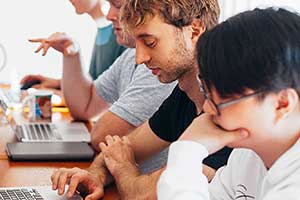Learning Circles
Overview
Learning circles are a flexible model of group learning in which people meet regularly to work on an online course together either in-person or virtually. They build a sense of community that supports individuals who might otherwise not engage or persist in independent learning. This peer learning experience can prepare adults for online learning and serve as an on-ramp to more traditional adult educational opportunities. Similar to a book club, a learning circle meets for 1.5–2 hours a week for four to twelve weeks, in a library, other community space, or virtually.
Learning circles were developed by Peer 2 Peer University (P2PU) to increase access to high-quality educational opportunities that are free to participants. P2PU offers a database of open-source online courses, a community of practice, online facilitator training, and a handbook for facilitating virtual learning circles. In addition, libraries can use the P2PU platform and tools to create a customized site for promotion, registration and group communication.
During the COVID-19 pandemic, virtual learning circles became a popular option for those who could no longer meet in person. Virtual learning circles may continue to be the preferred format for adults who want the convenience of joining from any location that has internet access. Library staff will need to determine if virtual learning is a good fit for the target audience.Some libraries are able to increase access to learning by lending devices such as laptops, tablets or hotspots. Here is an adaptable list of Frequently Asked Questions that libraries can use to inform patrons about their lending programs.
Facilitating a Learning Circle
Learning circles are led by a trained facilitator who can be a librarian, educator, or volunteer. They do not need to be a subject-matter expert on the learning circle topic. The facilitator’s role is to:
- organize the program
- provide an orientation to the online or digital learning resources
- facilitate discussions to support learning
- foster a sense of community
Library leaders and learning circle facilitators select the resources and design of the learning circle. Ultimately, meeting the needs of the target audience is the goal and might require modifying space for in-person meetings, adapting learning resources, or changing meeting times. Some libraries might even provide childcare to accommodate the needs of learners.
Certain basic conditions for success need to be in place to support the effective implementation of Mobile Learning. After considering the elements below, you can use this Self-Assessment tool to reflect on your current capacity and determine which elements are strong or need strengthening.
Conditions for Success
Implementation Examples
Click on the images below to learn how each library implemented Learning Circles.









